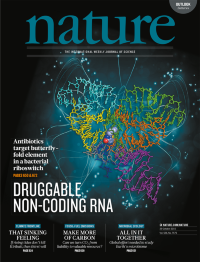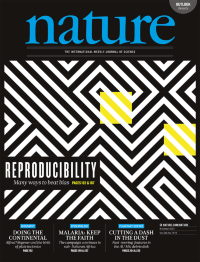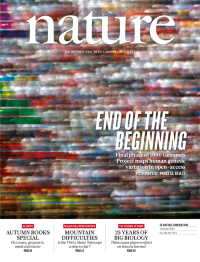Volume 526
-
No. 7575 29 October 2015
Co-crystal structure of the small molecule ribocil bound to the RNA aptamer of a bacterial riboswitch. The background image highlights the butterfly-fold conformation of the riboswitch aptamer observed upon ribocil binding. The urgent need for new antibiotics is well recognized. Terry Roemer and colleagues at Merck now describe a new synthetic antibiotic, directed against a bacterial riboswitch. Riboswitches are stretches of non-coding RNA whose structure is affected by a ligand � usually one related to the function of the protein encoded by the riboswitch-containing gene. The new drug, ribocil, blocks the flavin mononucleotide riboswitch-mediated expression of the ribB gene required for riboflavin biosynthesis. Ribocil inhibits bacterial cell growth and is effective in treating a bacterial infection in a mouse model. Cover illustration: Sharon M. OBrien.
Nature Outlook
-
No. 7574 22 October 2015
Tile scan immunofluorescence of a whole kidney organoid displaying structural complexity; actual dimensions are 5.7 mm × 6.4 mm. The development of the human kidney in the embryo depends on two different stem cell types, one to generate collecting ducts and the other to generate functional nephrons. Melissa Little, Minoru Takasato and colleagues showed previously that human pluripotent stem cells (hPSCs) can differentiate into both types of progenitors. They have now identified the signalling conditions required to induce not only these structures but also the surrounding cell types including interstitium and blood vessels. Using this approach, they have grown kidney organoids that recapitulate the functional regionalization of the embryonic kidney. The tissue complexity and degree of functionalization achieved in these organoids are not on a par with a working kidney, but replicate the normal human embryonic kidney. Importantly, they provide evidence of their potential in screening drugs for toxicity, modelling genetic kidney disease or perhaps to provide specific kidney cell types for cellular therapy. Cover image: Minoru Takasato
Nature Outlook
-
No. 7573 15 October 2015
The cover features axial projections of statistical maps obtained from 529 datasets shared through the Neurovault.org repository, arranged according to their projection into a two-dimensional space using independent components analysis. Studies into human brain function attract a great deal of attention in the media, but it is important to be aware of the limitations inherent in the methodologies used and in the way they are being applied. In this Review, Russell Poldrack and Martha Farah explore the techniques that are currently being used to probe brain function in humans, focusing in particular on the study of the neural bases of the mind, and discuss the ability of these methods to test hypotheses about causal mechanisms. They also consider several current and potential real-world applications of human neuroscience and the challenges involved. Cover: Russell Poldrack and Kelly Krause (source: neurovault.org)
Insight
-
No. 7572 8 October 2015
The need for replication and corroboration of research results is a vital part of the scientific process. But the complexities of the systems and techniques used today have made it harder for editors and referees to feel sure that a research result will stand the test of time. As part of a continuing series on the problem of irreproducibility, this issue of Nature includes two articles on ways of minimizing observational bias. In Comment, Robert MacCoun and Saul Perlmutter argue that more fields should, like particle physics, adopt blind analysis. In a News Feature, Regina Nuzzo reports on a range of tactics being used by concerned researchers to counter a human characteristic that scientists can display as much as anyone else � self deception. For Natures special collection on reproducibility, go.nature.com/huhbyr. Cover: Kelly Krause / Nature (adapted from Victoria Kalinina/Shutterstock)
Nature Outlook
-
No. 7571 1 October 2015
Two papers published in this issue report on the third and final phase of The 1000 Genomes Project. Begun in 2008, the project has developed an open resource that now includes the genomic data for more than 2,500 individuals from 26 global populations, all analysed using whole-genome sequencing, deep exome sequencing and dense microarray genotyping approaches. The main report from the consortium describes key features of all 88 million genetic variants identified, while an extended analysis from the Structural Variation Analysis Group provides a more detailed account of larger and more complex variants. The data are available via http://www.1000genomes.org/data. Cover image: Cahier Archive/Corbis





